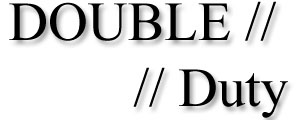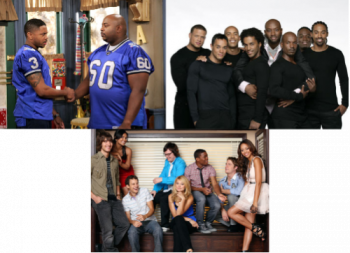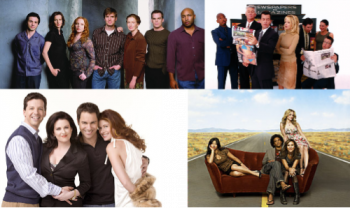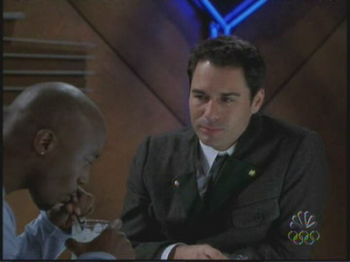Doing Double Duty: Toward a Theory of “Compound Otherness” on Television
Alfred L. Martin, Jr. / Flow Co-Managing Editor

Doing double duty. As a phrase it’s used to discuss when something is filling a dual function. Sometimes it can be an inanimate object like a car that is used for both business and personal use. As I am invoking the concept from a television studies perspective, it is used to describe the ways in which representations of otherness in majority white television shows is placed within one character of color. I am calling this concept “compound otherness,” which differs from colorblindness in three ways. First, “compound otherness” makes explicit reference to race, unlike colorblindness, which seeks (and fails) to transcend race as an issue; second, “compound otherness” deals with more than race as a type of otherness, and can include sexuality, socio-economic status, and nationality, among others, in order to represent several axes of difference in a single character. Concomitantly, “compound otherness” differs from tokenism in that tokenism often applies to difference along a single axis of difference whereas “compound otherness” works along several axes of difference simultaneously.
Specifically, I’ve conceptualized this term to apply to the ways in which black gayness is deployed in a bid to kill two (or more) birds with one stone (although this term can be applied outside of a black gay context). Put another way, including black gay male characters within otherwise white shows allows for the representation of a double dose of otherness – a black character to appease those, like the National Association for the Advancement of Colored People (NAACP), who call for “more color,” specifically on network television, and a gay character to appease those, like the Gay and Lesbian Alliance Against Defamation (GLAAD), who want more representations of gayness on television. The driving question behind the notion of “compound otherness” is: In a sea of white characters, is there a lone character who is tasked with representing all of the “otherness” the show presents to its viewers?

Because we often understand concepts in reference to its binary opposite, “compound otherness” doesn’t apply to a show like LOGO’s Noah’s Arc, which is set in a black gay community, largely devoid of whiteness and heterosexuality (although if there were a white heterosexual character, he or she would likely signify “compound otherness” as I’ve conceptualized it). Nor does it apply to a show like the UPN/BET show The Game where a black gay character is featured for a two-episode arc because he is simply gay in an otherwise black world – there is no compounding of otherness here. Lastly, “compound otherness” doesn’t apply to ABC Family’s Greek because while Calvin, is both black and gay, he is not tasked with representing the only black person nor the only gay person on the show. In other words, what makes “compound otherness” unique is that a single character does all the work of otherness in a text.

Several texts exemplify this concept as I’ve conceptualized it including NBC’s Spin City and Will & Grace, HBO’s Six Feet Under and ABC’s short-lived Emily’s Reasons Why Not. The space here does not allow for an examination of the ways each of these texts exemplify “compound otherness,” but I want to briefly assay Will & Grace to illuminate how the show fits within the framework of “compound otherness” as I am conceptualizing it. The decision to use Will & Grace to illuminate what I mean when I talk about “compound otherness” has nothing to do with the popularity or enduring cultural significance of the show. Rather, it is because the show marks an axis of otherness that is not often observed in American television: nation.

In Will & Grace’s eighth season, Taye Diggs portrayed James Hanson, a Canadian black gay man who also happens to be Will Truman’s love interest (at least for a four-episode arc). While the show has featured Gregory Hines as Ben Doucette, a love interest for Debra Messing’s Grace, and series regular Shelley Morrison as Rosario Salazar, there are two ways in which James Hanson’s otherness is compounded that separates him from those representations. First, Hines’ Ben Doucette is simply a black heterosexual man on Will & Grace, satisfying only one axis of difference – blackness. Heterosexuality is normative on the show as 50 percent of the series regulars are heterosexual and Grace is involved in far more romantic relationships than Will. Rosario does satisfy my definition of “compound otherness” in that she is both Hispanic and lower class. Viewers are to assume that although Will and Grace cohabitate for the majority of the show, that they are middle to –upper-middle class, Karen is certainly upper-class and Jack, although he only works odd jobs, manages somehow to be read as middle class (hence my assertion that this theory is expandable beyond the way in which I am developing it here). But James, who is more important for my theoretical endeavor, compounds otherness by embodying both race and nation.
For James, it is illustrative to look at the way in which the character is raced and sexualized in a way that marks his difference from these other characters of color. First and foremost, James is one of the few characters on network television whose gayness and blackness are made explicit. Instead of making viewers read race onto Diggs’ body, the dialogue over the course of his four-episode arc marks him racially as different. In one of the episodes, Grace is happy to participate in a “green card marriage” if only to send her mother a Christmas card with her black husband and Karen Walker gets a kick out of the notion that interracial marriages are legal. He is hypersexualized like the big black buck of stereotyping lore. This is particularly illustrative when several wedding guests (and Jack McFarland, Will’s best friend) allow that James could pound them each “like a piece of veal” reifying the danger associated with interracial coupling and the myth of sexual prowess of black male bodies.
[flv]http://flowjournal.org/wp-content/uploads/2011/08/The-Definition-of-Marriage-Clip1.flv[/flv]
In addition, Diggs’ James is marked as different with reference to nation, with the explicit subject positioning of him as Canadian. While the claim can be made that this marking of James as Canadian works as a plot device, I argue that it provides another axis along which to mark difference. One of the guests at the wedding asserts that he was unaware that they “built them like that in Canada.”
Most importantly, James is a black gay man (or a gay black man depending on how one reads him)1 – a little-seen creature on television – especially on a show that enjoyed/s ratings and critical success like Will & Grace. Because gayness is most often associated with whiteness2 in mass mediated discourses as well as Black Nationalist discourses, to see an explicitly black gay male body marks it as different (perhaps his Canadianness is specifically used as a plot device to place his outside of an American notion of blackness and a mythical black community?). His black gay body, like his black body, is sexualized in a way to which other characters are not subject. Jack, although allegedly Will’s best friend, offers to host a naked bachelor party with just Jack and James as invited guests.
As media scholars continue to examine the types of representations on television, particularly with a critical eye toward the ways in which minority bodies are constructed, it’s important to examine the ways in which single minority bodies are called up to represent many axes of otherness. Are these shows being touted for their representations of black men and gay men when those characteristics really represent “compound otherness?”
Image Credits:
1. The Oh Boy Files
2. The Game photo from TV Guide Online, Noah’s Arc photo from Los Angeles Daily News, and Greek photo from Technically Personal.
3. Spin City photo from Rocky Music, Will & Grace photo from DVD Set Shop, Six Feet Under photo from Reign of Error, and Emily’s Reasons Why Not photo from WCHS-TV.
4. Rod 2.0.
5. Video from author’s personal DVD collection.
Please feel free to comment.
- See Darieck Scott, “Jungle Fever: Black Identity Politics, White Dick and the Utopian Bedroom,” GLQ: A Journal of Lesbian and Gay Studies 1, no. 3 (1994), 299-331 and Gregory Conerly, “Are You Black First or Are You Queer?” in The Greatest Taboo: Homosexuality in Black Communities, ed. Delroy Constantine-Simms (Los Angeles: Alyson Books, 2001) on this debate. [↩]
- See Richard Dyer, White, (New York: Routledge, 2007), 12, and Allan Berubé “How Gay Stays White and What Kind of White It Stays” in The Making and Unmaking of Whiteness, eds. Brigit Brander Rasmussen, Eric Klineberg, Irene J. Nexica and Matt Wray (Durham: Duke University Press, 2001). [↩]
Hey Al – great article, and a really grabbing idea. After reading, I found myself wondering with Will & Grace if sexuality is to it what race is to Noah’s Arc? It feels to me with W&G (just thinking out loud), there’s a sort of implied, ‘He’s gay until proven straight’ imperative that even the men Grace lusts after are still subject to. I think there’s even a “Does Grace like him?” “YAH” “Then he’s gay.” rat-a-tat that goes along with that. I think most of the characters are queered, even, including Rosario, because that sort of “all-gay world” isn’t realistic (read: confrontational) to the mostly straight, white audience. I suppose if that were true, stangely, a straight black man on W&G would be queered …
Thanks for a really provocative post.
I really like that you have included nation into your equation, as this seems to both mark another level, if not category, of “otherness.”
One tendency in American humor that I’ve noticed (as a foreign national) is that as the bounds of making fun of one another within the nation diminishes (due to political correctness, etc), making fun of other nationalities is still more than fair game. Representations of other nationalities also seem to be marked as open signs to some degree, so that their “difference” can stand for whatever writers happen to want them to, as in the case of your argument for “double duty” here. (Robin, on How I Met Your Mother, and her gun fetish is also fairly inexplicable to me, but I think another example of how this works)
The scene that you present is also pretty ironic, considering that Will (McCormack) is not only not gay, but is also not American (he’s Canadian), which I think complicates things even further.
Taylor,
Thanks for your insightful comment. I think part of this “compound otherness” that gets placed onto black bodies often ends up becoming hypersexualized. For both James on Will & Grace and Keith on Six Feet Under, a degree of sexuality is placed within these characters to which other characters are not privy. However, I don’t think the love interests for Grace are queered because, I would argue that Will & Grace is predicated on the notion that heterosexual love is “normalized.” The first episode of the series’ run is set up as if Will and Grace are having a hot sexual phone conversation — in many ways working from a slightly altered version of Stephen Tropiano’s “Mistaken Identity” episode. The exception here, I would argue, is Karen, who is most definitely queered throughout the series.
Colin, I’m glad your enjoyed the piece. I liked that Will and Grace looked at nation for two reasons: first, because it reifies the notion that Canadianess is the “right” (or at least acceptable) kind of North American nationhood (versus being Mexican). Second, Canadianess is a fairly transparent kind of nationhood (and otherness). Because American audiences have little knowledge about Canadian culture (other than that we think they say the words “out” and “about” “funny”) it is blank slate for us to make this kind of otherness whatever the narrative needs it to be. So, under the rubric of Canadianess, we can still map hegemonic notions about black male sexual prowess onto him as well as criminality and un-trustworthiness (which become the way in which the show gets rid of his character). While, Will & Grace makes has an explicit conversation about James’ raced body (in an objectified and sexualized way), race is not the reason this relationship dissolves — as I’ve argued elsewhere, there has to be a reason other than race to break them up and that reason is that James cannot be trusted and that Will “doesn’t really know him.”
Al, this is an intriguing article. I found myself pondering this phrase,” particularly with a critical eye toward the ways in which minority bodies are constructed, it’s important to examine the ways in which single minority bodies are called up to represent many axes of otherness.”
I was fascinated by the simple clarity of the implications here. Understanding representations as “constructed.” You challenge us to see, perhaps, a new dimension of “intent.” We can pose the question to the producers of this media text,”did you intend to “bundle” otherness, and if so, why?” This is full of good, clean, socio-political fun.
Great job, Al! I love the concept of “compound otherness.” One thing that intrigues me about the concept really hits the heart of “doing double duty”–people are able to laugh at the way someone is “othered” while also affirming and (continuing to) other them. This really hit home in the clip. James is mocked for being Canadian but then accepted when his hypersexualization is confirmed by multiple people. It makes him an acceptable “other.” Great, thought-provoking piece.